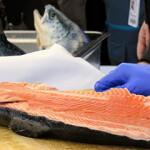Gulf fisheries suffer major losses; recovery underway

After devastating commercial fishery losses in Louisiana and Mississippi following freshwater intrusion from the Bonnet Carre Spillway opening earlier this year, officials are working on recovery efforts.
On 6 September, the Mississippi Department of Marine Resources (MDMR) and the University of Southern Mississippi Gulf Coast Research Laboratory released around 90,000 juvenile spotted seatrout (speckled trout) into Hancock County waters.
The trout is the most popular inshore fish and is vital for both commercial and recreational fishermen, Dr. Paul Mickle, chief scientific officer at MDMR, told SeafoodSource.
“We have a quota on commercial Spotted Seatrout at 50,000 pounds a year. Our restaurants on the Mississippi Gulf Coast use it and it is and exported out of the state. It is very important to the Coast culture,” Mickle said.
The Bonnet Carre Spillway opening this spring, designed to alleviate flooding along the Mississippi River, has had a devastating impact on commercial fisheries.
In Mississippi, landings of all shrimp are down 60 percent as of the end of July, while brown shrimp landings are down 85 percent, compared to the five-year average, Joe Spraggins, director of the MDMR, told SeafoodSource. What’s more, blue crab landings dropped 40 percent, and oyster mortalities are between 95 and 98 percent.
“By far, it is the worst shrimp season my father [Jerry Forte] has seen since the ‘70s,” Jeremy Forte, assistant manager of Jerry Forte Seafood in Pass Christian, Mississippi, told SeafoodSource in June.
“When all the freshwater comes flying in the Mississippi Sound, it displaces our crab, finfish, and oysters. There are massive negative impacts. They move out of the way and then don’t come back or come back very slowly,” Mickle said.
Spraggins will testify before the U.S. Senate Commerce Committee later this month to urge funding for commercial fisheries.
“It is not just [damage] this year; it is a long-term effect. As far as the oysters, it is going to take five to 10 years to get it back, and three to four years for the crabs,” Spraggins said.
In addition to damage to the fisheries, consumer perception and tourism has also been harmed.
Algae blooms developed in Lake Ponchartrain in Louisiana and some areas of coastal Mississippi after the Bonnet Carre Spillway opened, which lead MDMR to advise the public to not eat fish or any other seafood taken from “affected waters or in proximity to the beach closures” in June.
The Louisiana Department of Health also warned the public about a potentially large algae bloom that is developing on Lake Pontchartrain.
“While algae toxins have not been found in the edible parts of fish, LDH advises that fish not be harvested or eaten from the lake during the bloom,” the agency said in a statement earlier this summer.
However, seafood is routinely tested for toxicity from the algae blooms and “we have not found any issues,” Spraggins said. “It is going to take time for people to understand that the seafood was not affected.”
Meanwhile, MDMR will release red drum and southern flounder to help rebuilt the populations of those fish in the future.
“They are coming online in the next year or year-and-half at our hatchery in Gulfport,” Mickle explained.
Photo courtesy of Shutterstock






Share